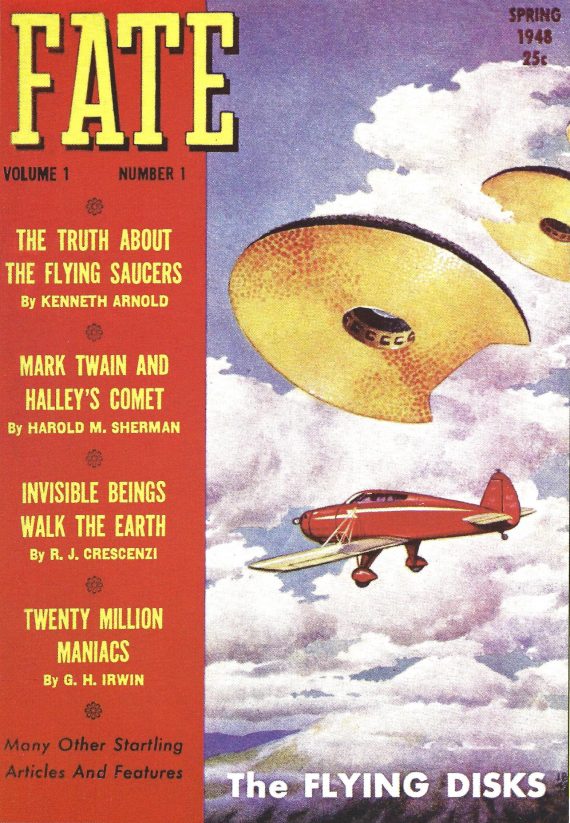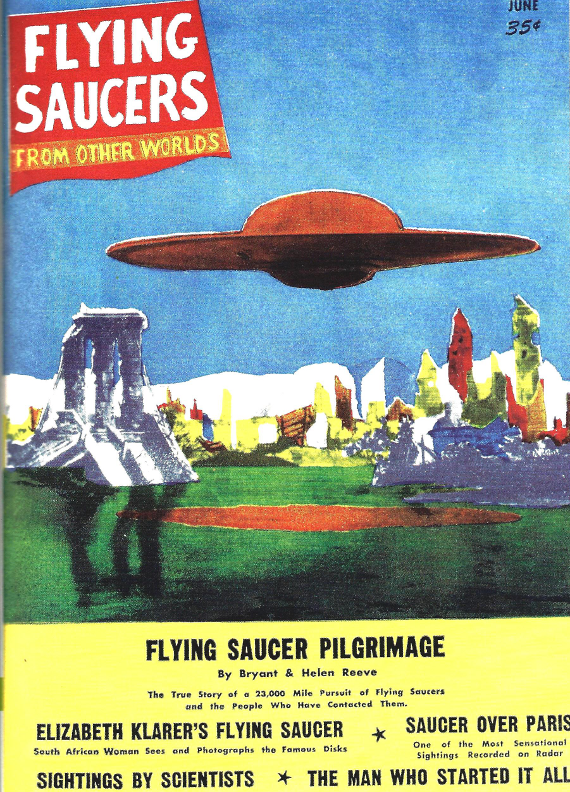
Part 2 of Fanzine review: OPUS #20

Opus (V.2 #7 Whole Number #20) January 1953
Faned: W. Max Keasler
Of supreme interest (to me at least) is that this column “The Club House” (which I always refer to as ‘Clubhouse’) started up in the pages of AMAZING in March of 1948 with Rog Phillips as the first columnist, the concept of the column and its title having first been conceived by then AMAZING editor Ray Palmer.
Ah, Ray Palmer, about whom Harry Warner Jr. wrote “Palmer is the type of person around whom legends cling.”
As you may recall my last Clubhouse column was devoted to Richard Elsberry‘s review of the Worldcon in Chicago in 1952. It so happens Ray Palmer was one of the pros appearing at that convention and Elsberry made mention of him. Hence Palmer’s appearance in this column.
Ray (born in 1910) became a fan in 1929 with his purchase of the first issue of AMAZING, was one of the founders of the Science Correspondence Club in 1930 and was the creator and editor of its club organ THE COMET (which some consider the first fanzine) which came out in May of that year. He rather quickly turned pro with his first short story sale being “The Time Ray of Jandra” which appeared in WONDER STORIES, also in 1930.
In 1938 Ziff-Davis bought AMAZING and fired its editor T. O’Conor Sloane who was “tottery with age” as Harry Warner Jr. put it. Ralph Milne Farley (a popular pulp writer) recommended Palmer to replace him. Palmer applied in person at the Ziff-Davis office in Chicago and was hired the same day. He remained as editor of AMAZING for over ten years.
As a fan Palmer had written “As for what’s wrong with science fiction, nothing. The trouble is with the editors. They have found a certain type of fiction which sells their magazine. They are interested solely in profit. And they will not change. How to remedy this? You can’t.”
You might say Palmer had a vision of what a prozine SHOULD be. Upon landing the job as Editor of AMAZING, it soon became obvious he intended to pursue this goal relentlessly.
“Here at last,’ Palmer said, ‘I had it in my power to do to my old hobby what I always had the driving desire to do to it. I had in my hands the power to change, to destroy, to create, to remake at my own discretion.”
Initially, at least, he took it upon himself to rewrite almost every story he accepted. As editor of POLAR BOREALIS Magazine I must say that’s an awfully tempting policy to follow, but it’s far too much work and I can’t think of a better way to annoy and upset authors. Even the legendary J.W. Campbell only suggested rewrites along specified lines, I don’t think he bothered rewriting the stuff himself. Palmer’s methods do show how serious—not to say obsessed—he was at realizing his vision.
Some critics argue he made the zine more juvenile in character, others that he made it more lively. He himself claimed that he increased circulation from 27,000 to 185,000 which does indicate he was doing SOMETHING right to make it more popular. But what price popularity?
In the March, 1945, edition of AMAZING, Palmer published a story by Richard S. Shaver titled “I remember Lemuria.” Subsequent stories elaborated the central premise of thought records preserved in deep caverns. Modern fans may not know anything about this bizarre “conspiracy” theory, so I present Harry Warner Jr.’s summation:
“Essentially, Shaver’s long series of stories offered this set of modern claims, presented as truth: that the author had discovered in these caves an alphabet from which all present languages derive; that these caves are miles deep, carved thousands of years ago, and full of wonderful machines as well as degenerate humans known as deros; that originally the caves were tenanted by elder gods, more advanced mentally and spiritually than present men; that after these elders left Earth for other planets, men found their way into the caves and degenerated because they operated the machinery in such a clumsy way that harmful rays came forth; that to date these deros have been fighting among themselves too much to cooperate in an attack on mankind; and that mankind is in double trouble because the sun emits detrimental rays causing old age and death, the cause of the elder’s climbing down into the caves in the first place.”
Right. And I’m the Queen of Sheba.

[Note: That’s Ray Palmer on the cover of MYSTIC]
I can tell you my immediate reaction, had I been alive and a fan in the decade before I was born, I would have stopped reading AMAZING. I would have been as incensed as Forrest J. Ackerman who felt that Palmer was bringing science fiction into disrepute. No longer “that Buck Rogers stuff,” it was now “that stupid dero stuff.” Yet people ate it up. In presenting a full-fledged conspiracy theory revealing the hidden truth behind reality Palmer was prescient and way ahead of his time. It certainly rang the cash register.
One asks, how dumb can people be? As Harry Warner Jr. commented “The entire Shaver mythos is so obviously derived from the Lovecraftian fictional background that it is hard today to imagine that it impressed any experienced readers.” How about experienced thinkers?
Personally I explain the phenomena with my theory that people who feel powerless and victimized flock to any theory which offers them the complacent satisfaction of being one of the very “few” who know the “real” truth. Crankism as self-defence. Then again, maybe that means I’M crazy.
Be that as it may, in 1949 there came a parting of the ways, brought about for reasons never explained by either Ziff-Davis or Palmer. One possible hint occurs in Harry Warner’s comment “that Palmer shared with almost every prozine editor in history the unshakable certainty that fans were too few numerically to be important, too eccentric in their opinions to be reliable guides to how to edit a professional magazine, and too much of a nuisance to be ignored.”
Could it be prolonged fannish opposition to the Shaver Mythos that moved ZIFF-DAVIS to move Palmer out? Or was it was his insistence that an entire issue of AMAZING be devoted to the flying saucer craze, a proposal that was rejected; so he started up a magazine of his own in 1948 titled FATE which dealt with Shaver’s writings and flying saucers? Or could it be because in early 1949 he started up a second prozine of his own titled OTHER WORLDS which Ziff-Davis probably considered unfair competition subsidized by Palmer’s salary? I have no idea. Maybe they just got tired of each other.
Point is in 1952, at the time of the Chicago Worldcon, Ray Palmer was publishing an SF prozine titled OTHER WORLDS, which was being co-edited by Bea Mahaffey partly because Palmer had health issues, and the occult/flying saucer magazine FATE. He had also started up an SF zine called IMAGINATION, secretly co-edited by Bill Hamlin who was still working for Ziff-Davis at the time, but by the convention had sold it outright to Hamlin.
You might imagine that being a professional publisher of two (presumably) popular magazines would be immensely profitable and the offices of such a publisher would reflect the status and prestige of the publisher. The latter part is correct.
Friday morning at Chicon II, with not much happening, Richard Elsberry decided to launch an expedition to visit Palmer’s office. Fans Frank Dietz, Bill Hamlin and Bob Rossling came along. Hamlin especially important since they were using his car.
“We had a hard time finding 1144 Ashland. Ashland is an extremely short street, and is right in the heart of the residential section. The address we pulled up to looked like it had once been a grocery store. It was deserted inside. There was no visible evidence to show that this had once been the offices of OTHER WORLDS.”
“Dietz somehow got down into the cellar, and called up, ‘This is the place, all right. There are lots of OTHER WORLDS and FATEs stacked on the floor down here.’ Dietz prowled around among washing machines and water heaters, but could find nothing else. Coming out the basement door we ran into a woman with a little girl. We told her we were looking for the offices of OTHER WORLDS.”
“Oh, they moved some time ago,’ she told us. We got the general location of the new address and piled back into the car. We took along a few copies of OTHER WORLDS so they’d recognise us.”
Hmm. I guess the early fifties were a different time. Can you say “Breaking and entering?” “Trespassing?” “Theft?” I wonder how Chicago beat cops would have reacted had they discovered these ballsy fans.
“Down by the ‘L’ we found the new office. This time we decided it was a converted dry-cleaning establishment, or a laundry. The outer office was completely barren except for a couple of paintings, and a display of OTHER WORLDS and FATE along the windows. We found the offices in the back room. Four or five people were busily at work, answering correspondence and filling orders for back issues. Neither Palmer nor Mahaffrey were around.”
“A cute brunette receptionist named Carol Burke, whom Tucker had told us to watch for, talked with us for a while, but there wasn’t much else to see, save a large wall circulation map of the United States, elaborately decked out in coloured pins.”
“We thought we’d drop over to Bill Hamlin’s offices, but no one knew where they were. And although we stopped in several drugstores we couldn’t find any copies of IMAGINATION.”
And you thought prozine publishing was a lucrative and glamorous business! Most magazines, then and now, are always on the verge of financial collapse. At least Palmer was keeping his costs down.

Back at the convention there was an editors’ panel on Saturday, starting at 1:00 PM. It featured Tony Boucher of F&SF, Howard Browne of FANTASTIC, John W. Campbell of ASTOUNDING, Mrs. Evelyn Gold for GALAXY, Lester del Ray of SPACE SCIENCE FICTION, Sam Mines of STARTLING STORIES, William Hamlin of IMAGINATION, and Ray Palmer of OTHER WORLDS.
“This was the panel of editors, moderated by Diane Reinsburg. It was not enough that Mrs. Reinsberg was a singularly inept moderator, but we also had to contend with the continual distraction of Merril Gwosdof running on stage to fix his recording microphones.”
“John Campbell, the most interesting and penetrating editor in the group, said that his policy is ‘exploring the future.’ Campbell believes that each issue is an experiment. He wants to find out what type of story you like, but not what certain stories you liked. Campbell wants to find an over-all theme to follow.”
“Sam Mines said that his fan columns are just for laughs. He also thinks that ‘fans are probably people.”
“William Hanlin, an easy-going sort of guy, stated that the chief charge hurled at IMAGINATION is that it is a ‘professional fanzine.’ Mr. Hamlin said that he considers this the highest form of compliment. I wonder what he considers an insult.”
“Ray Palmer’s important point was that Bea Mahaffrey now has equal editorship with him, that carrying the right to buy and reject stories.”
The day before Palmer shared a panel with Willy Ley, one of the founders of the German Rocket Society in 1927, and whose gigantically influential 1944 book ROCKETS, MISSILES, AND MEN IN SPACE had already been reprinted six times by the time of the convention. The panel subject? “Flying Saucers—What Are They?”
Ley commented that they were definitely not U.S. or Russian air force experiments, that 80% were natural phenomena and the remainder something unknown but probably not “visitors from other planets.”
“Ray Palmer, on the other hand, quite obligingly stated, ‘Buy my magazine and I’ll tell you about the flying saucers.’ When Palmer finished, discussion period was opened. Sam Moskowitz was the first one to ask a question.”
“Have either of you ever seen the Brazilian flying saucer pictures?’ he asked.
“I have,’ said Ley.”
“I have,’ said Palmer.
“I now pronounce you man and saucer,’ said Lee Bishop in a voice that carried only to those at our table.”

Safe to say Palmer continued to ride the flying saucer bandwagon. In 1953 Palmer suspended OTHER WORLDS, taking over UNIVERSE SCIENCE FICTION, then changed its name yet again to OTHER WORLDS in 1955. More and more UFO articles appeared beside the continuing Shaver Mythos material. In 1957 he went whole hog and changed the name to FLYING SAUCERS FROM OTHER WORLDS. It featured a personals column so saucer fans could get in touch with each other, encouraged saucer fen to form clubs, and brought attention to flying saucer fanzines like UFO HOTWIRE and THEY KINGDOM COME.
Flying Saucer fandom. Agggh! I’ve lost track of how many times, when mentioning to someone I like science fiction, the response has been “Oh, one of those flying saucer nuts, eh?” or worse “You like flying saucers too? Wow! So do I!”
Many people think SF fans and UFO fans are one and the same. Drives me nuts.
The deros are largely forgotten. But saucer mania is as strong as ever among true believers. Is this the legacy of Raymond Palmer?
Not just. At the very least, if it weren’t for Palmer, I wouldn’t be writing a column called “The Club House” for AMAZING. And that’s amazing.
Getting back to the original Club House column, Warner quotes Vernon L. McCain (a prolific fanzine article writer and Loc writer) as saying “The Club House had done more to make fandom grow than any other single force in history, and it altered the whole character of fandom by bringing in a different type person. Not that this new type was in any way superior or inferior to the old type, but they were different and they changed fandom. Many of us preferred the old type to the new, which somewhat resembled a combination of the American Legion and the Housewives’ Thursday Knitting and Tea Auxiliary. Less publicity is what fandom needs.”
Damning with faint praise. My goal is more modest. I’ll settle for either.
BY THE WAY:
You can find a fantastic collection of zines at: Efanzines
You can find yet more zines at: Fanac Fan History Project
You can find a quite good selection of Canadian zines at: Canadian SF Fanzine Archive
And check out my brand new website devoted to my OBIR Magazine, which is entirely devoted to reviews of Canadian Speculative Fiction. Found at OBIR Magazine
And while checking out OBIR, click on the sub-heading “Polar Borealis Magazine” to see the first issue of my semi-pro SF&F fiction zine.










